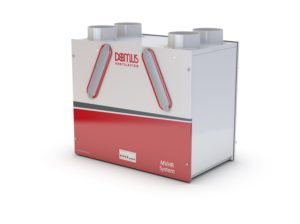 David Treharne, Senior Engineer at Domus Ventilation, looks at how improvements in the energy efficiency of dwellings has led to poor indoor air quality, and why mechanical ventilation is the way forward…
David Treharne, Senior Engineer at Domus Ventilation, looks at how improvements in the energy efficiency of dwellings has led to poor indoor air quality, and why mechanical ventilation is the way forward…
Over recent years we’ve done a good job of improving the energy efficiency of new build homes, with a focus on sealing the building envelope to prevent wasteful heat leakage. And it’s worked remarkably well; so much so, that we’ve created air tight homes that, in some circumstances, over heat and trap the stale, humid air indoors along with the pollutants. You see, what we’ve failed to do is match the improvement in energy efficiency with the provision of ventilation.
The Results of poor ventilation
As well as making for an uncomfortable home environment, poor ventilation can directly affect the health of residents. Poor indoor air quality (IAQ) has known links to allergies, asthma, lung cancer, chronic obstructive pulmonary disease, cardiovascular disease and even dementia. Research conducted by the University of Exeter Medical School amongst social housing in Cornwall found that for every increase in SAP (Standard Assessment Procedure) ratings – which is used to measure the energy efficiency of dwellings – there was a 2% increased risk of asthma. The UK already has one of the highest occurrences of asthma in the world and we are unwittingly making this worst.
Why not just open a window or two if you need ventilation is a common refrain, but in cooler or damp weather that’s not ideal, nor is it enough in warmer summer months. That’s where continuous mechanical ventilation systems steps in.
Continuous mechanical Ventilation
Building Regulations Approved Document F details the different types of ventilation suited to a domestic property starting from a System 1 which is Intermittent Extract Ventilation, but for whole house continuous mechanical ventilation systems you are looking at a choice between a System 3 Continuous Mechanical Extract Ventilation (MEV) or a System 4 Continuous Mechanical Ventilation with Heat Recovery (MVHR).
An MEV system actively extracts air from ‘wet rooms’ (kitchens, bathrooms, utility spaces) via ducting to a central ventilation unit which further ducts to an exhaust point. The systems are typically dual speed, providing low speed continuous trickle ventilation and high-speed boost flow. Replacement fresh air is drawn into the property via background ventilators located in the habitable rooms and through air leakage.
A sub-set of System 3 is Decentralised Mechanical Extract Ventilation (dMEV). dMEV systems are an extremely cost effective and easy to install ventilation solution. They offer continuous low levels of ventilation to a single wet room, coupled with virtually silent operation.
Unlike MEV, MVHR systems combine supply and extract ventilation in one system. They work on the principle of extracting and re-using waste heat from wet rooms. MVHR systems efficiently pre-warm the fresh air drawn into the building with waste stale air using a heat exchanger; up to 95% of waste heat can be recovered by this mechanism. The filtered, pre-warmed air is then distributed around the home, effectively meeting part of the heating load in energy efficient dwellings.
Waving the flag for MEV
There’s no doubt about it, MVHR systems provide effective ventilation, are energy efficient, extremely effective at reducing the risk of condensation and cold air draughts and, with their built-in air filters, are particularly useful in more polluted urban areas. They are the champions of domestic ventilation!
But MVHR systems also come with a higher price tag than their counterparts and are considerably more complex to install and commission. MEV systems, which are more affordable and straight forward, are often a more practical solution. MEV still provides excellent ventilation, but the capital costs are lower, they are easier and therefore more economical to install and operating costs are low.
On the installation side, MEV systems require less ducting because air is being drawn one way only: out. With an MVHR system there is a further set of ducting to take the air from the unit into rooms. This also has a direct impact on the level of commissioning required. Commissioning involves marrying the unit’s performance to the actual air flow passing through the valves situated throughout the property. As MEV systems have extract valves only this is a relatively straightforward process, unlike MVHR systems which must balance the extract and supply rates.
The MEV units themselves are smaller and lighter than those of MVHR and can therefore be easily wall mounted rather than in a loft. In fact, Domus Ventilation’s CMX-S MEV unit is just 125mm deep, making it the only unit on the market shallow enough to fit in a ceiling void.
MEV systems are also very easy to use – more of a fit and forget scenario than MVHR systems which require maintenance, including regular filter changes. In the case of our own CMX-S MEV system, the optional speed and user controls enable simple operation and control for the homeowner, making them less likely to experience difficulties. Models are also available with an integral humidistat which identifies changes in humidity and automatically adjusts the air flow of the unit accordingly. With access to properties often an issue in social housing, MEV systems are often a more appealing option here.
Both MEV and MVHR systems are most suitable for new properties rather than retrofit (although that is an option in some circumstances), but MVHR systems really do require a more airtight property where virtually all of the air flow can pass through the heat exchanger, if they are to perform efficiently. The ventilation industry considers a figure of <3 of the permeability figure of <5m³/h per m² to be the most appropriate for a dwelling which is intended to be fitted with an MVHR system. MEV systems aren’t restricted to this, so can be used in a wider range of settings.
Interestingly, with inner cities obviously having higher pollution levels, MVHR systems are seen as more suitable because of the filter element, but in apartment blocks it is often the case that only the first four floors are fitted with MVHR and the remaining with MEV as polluted air is heavier and therefore stays closer to the ground.
Onwards and upwards
The issue of IAQ is finally making it onto the political agenda. An All-Party Parliamentary Group for Healthy Homes and Buildings has been set up to investigate IAQ more fully and trade association BEAMA has put through recommendations for addressing this, which includes rewriting Building Regulations concerning ventilation so focus is given to achieving performance in practice, not just theory.
This is all positive news for professionals involved in ventilation or considering moving into this field as it represents a potential growth area.
It’s also positive news for all. After all, in the UK we spend around 90% of our time indoors and around 16 hours a day on average at home; we wouldn’t accept drinking poor quality water from our taps at home, so why should we accept breathing poor quality air?

